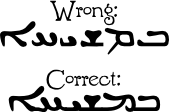For those of you who haven’t seen the above words, let me tell you where they come from.
“Sylvia Browne (born Sylvia Celeste Shoemaker 1936-10-19) is a bestselling American author on the subject of spirituality and is a celebrity psychic and medium,” if Wikipedia is to be believed. She’s a regular on the Montel Williams show, she founded the Novus Spiritus church, and has a very large following.
At three times during the Novus Spiritus service, the following is recited:
Arem, Shem, Beth, Sedal, Sacrivalian, Ahad.
Although it has been claimed that it is in Aramaic, it really puzzled me, because in her book “Prayers” (published in 2002) and on the
Novus Spiritus website, it is translated as:
“Blessed be this Queen on high who is sacred to all who come to Her. Amen.”
I was a bit dumbstruck. To me, this is a bunch of jibberish; nothing nearly so structured as how it is being interpreted. Let me break things down:
Arem
It could be ארם [‘arem] which is not really an Aramaic word in and of itself.
This form could also be the Hebrew name for Aram, the son of Shem.
It could also be ארים [‘areym] from the root רום [rom] which could mean “raised” in the causative (as in something caused to be raised, physically or in tone). But this would be better expressed as מרים [mirîm].
It could be ערם [`eram] which:
In Syriac (ܥܪܡ) could mean “rough spot,” or “scandal” (!) (but this is usually found in the form ܥܪܡܐ [`arma’] in Syriac.
Shem
It could be שם [shem] which means “name,” (which is the most common) but by idiom can mean “title,” “reputation,” (e.g. “good name” or “bad name”) or “authority” (i.e. “in the name of X”).
It could be שם [sham] from the root שום [shom] which means in some dialects “evaluate!” or “identify!” (as an imperative).
Beth
This I believe can be only one thing, which is the word בית [beyth] which means “house” (and associated idioms, like “family,” “structure,” “place.” etc.) or the second letter of the Aramaic alphabet (ב).
In some rarer cases it can mean “between” but that is in Syriac.
Sedal
The only word that jumps into mind for this one is ܣܕܠܐ [sadla’] whose absolute form is ܣܕܠ [sedal]. This, however, is a minority form of a Syriac word for “sandal,” a dialect far too young for Browne’s claims. Furthermore, the much more common form is ܣܢܕܠܐ [sandla’].
Sacrivalian
There is no way that this word is Aramaic.
After many hours of searching through my collections and databases, the closest possible thing I could find is סיקיר בליון [seyqeyr balyon] which means “a sausage-maker’s amulet,” but these two words (since they come from different dialects) have never been historically attested together in this fashion… ever.
That just sounds… Ick.
Ahad
This could either be the word אחד [‘echad] which is Hebrew for “one.”
Or… well I don’t know. That’s really all that comes to mind immediately.
It could be a verbal form
One very important and striking word that I was expecting to see, given the translation, was “Amen” as “amen” in Aramaic is … well אמין [amen]. Other than that, I would have expected מלכה [malkah], מלכת [malkath] or מלכתא [malkthâ’] which means “queen,” the adjective קדיש [qadîsh] which means “sacred” or “holy,” and at least the adjective בריך [brîkh] which means “blessed” as all three of these words are, to my knowledge, found every dialect on record.
In short: This jumble of syllables is certainly not Aramaic.
Now, another thing to note about Sylvia Browne is that she (and her estranged husband) were several times in the past convicted for fraud. Not to be too biting, but I believe that this leopard has merely whited out its spots. Aramaic is an obscure enough language for people to make wild and generally unchallenged claims about it. Hopefully this issue is now a bit less clouded.
Peace,
-Steve


